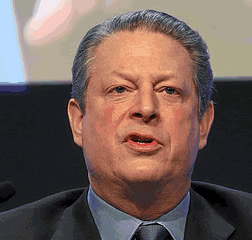
I went to see Al Gore’s disaster movie about climate change, An Inconvenient Truth. Unusually for a disaster movie, maybe, it focuses not on the disaster as it unfolds but on how to prevent it. Perhaps the hints of what might happen – floods, hurricanes, droughts – are more powerful than bold but inevitably uncertain predictions of what will take place.
But not too uncertain, as the film explains.
When I worked on this issue professionally, some 16 years ago, the arguments about the threat of global warming were based on a theoretical understanding of the atmosphere and how it works and not on any recent experience of increased temperatures. The scientific consensus of the time was that increased levels of carbon dioxide in the atmosphere due to human activities would lead to increased average temperatures around the world as a result. The scientific consensus now is that those increased average temperatures are already happening. The processes that lead to global warming are taking place more quickly than anybody had supposed.
Al Gore’s film gives examples of some of these unexpected developments, unexpected for their speed, that is. For example, according to the best science of 20 years ago, the polar icecaps shouldn’t be melting yet. But melting they are, day by day. It’s a worry.
For reasons I am about to explain, this is not only a great film but also a relevant film. Go and see it. (Find out more about it here.)
It is a relevant film because of what climate change says about contemporary decision-making in politics. National governments can’t protect their citizens, no matter they try and do. It is going to need more than that. Read an explanation of this here.
Al Gore is ready to place the fight against climate change in a grand political tradition, starting with the American revolution and running through the end of slavery, female suffrage, the defeat of the Nazis, the spread of non-violent protest, and the end of the cold war. However, he doesn’t quite take the next step forward in thinking about the politics. He quotes Winston Churchill from 1936, warning about the need to confront the Nazis. I suppose an American audience will like this. But just because Churchill said something doesn’t necessarily make it right. One of the icons of non-violence he shows is Gandhi, of whom Churchill was a bitter opponent.
If Al Gore is going to quote Churchill in his own case, there are better arguments to turn to. How about the offer in June 1940 for a federal union between Britain and France? An extraordinary offer to deal with an extraordinary threat. Quote that. Or his speech in Zurich in 1946 calling for “a kind of United States of Europe”.
The parallels are strong. For example, the film shows a map of the Netherlands as it would be if the Greenland ice sheet melted, that is to say mostly sea. If global warming should proceed, the Dutch are in great danger. But they cannot protect themselves on their own: most of the greenhouse gases are emitted by other countries, not the Dutch themselves. In the 1930s, before, the Dutch were threatened from abroad, namely by Hitler just over the border. At the time, the Dutch strategy for protecting themselves was to avoid giving offence. They studiously refused to enter into a military pact with Britain and France, preferring the option of neutrality. (It had worked during the first world war.) However, faced with a new threat unlike the previous one, the old strategy failed and the Dutch were duly invaded and occupied, at great cost inter alia to the Dutch Jewish community.
Since then, of course, the creation of the European Union has created a wholly new type of relationship between Germany and the Netherlands, and the Dutch no longer fear invasion and are no longer compelled into silence for fear of provoking attack. That new type of relationship is exactly what Churchill was calling for. Al Gore should have gone further in his film and quoted Churchill not only on how bad the threat from the Nazis was but also on how to resist it.
